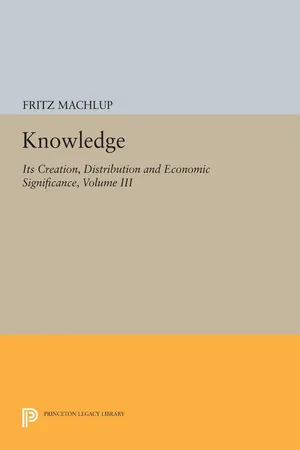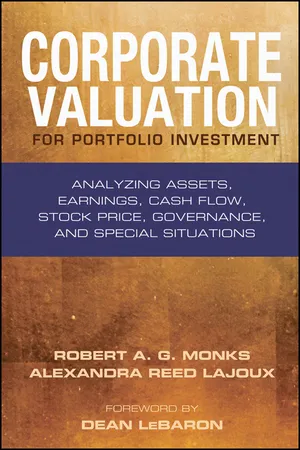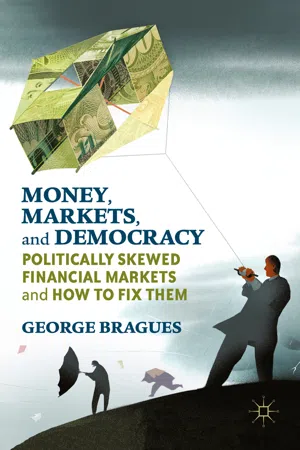Business
Stock Prices
Stock prices refer to the current market value of a company's shares of stock. They are determined by supply and demand in the stock market and can fluctuate based on various factors such as company performance, economic conditions, and investor sentiment. Investors and analysts closely monitor stock prices to make investment decisions and assess the overall health of the stock market.
Written by Perlego with AI-assistance
Related key terms
1 of 5
5 Key excerpts on "Stock Prices"
- eBook - PDF
Knowledge: Its Creation, Distribution and Economic Significance, Volume III
The Economics of Information and Human Capital
- Fritz Machlup(Author)
- 2014(Publication Date)
- Princeton University Press(Publisher)
The last two of these functions—generating the right prices to guide investors, and providing a forum for the price-guessing contests of stock-market players—are connected: the bids or offers based on the judgments of all market participants, be they investors or speculators, determine the prices of the stocks traded. This is not to say that each player who acquires a particular stock has done his own analysis of its "real value" or its prospect for a rise; many, perhaps most buyers of common stock rely on advice by professional investment analysts, stockbrokers, or supposedly well-informed friends and acquaint- ances. Several mutually conflicting theories "explain" the processes by which buyers, sellers, advisers, and tipsters reach the judgments that determine the decisions to buy or sell and, consequently, the movements of Stock Prices. Perhaps though, the alternative tech- niques of valuating stocks or predicting changes in their prices are used simultaneously by different groups operating in the stock ex- change. This would make it even harder to explain why Stock Prices have moved as they have, or to predict how they would move in the future, especially in the short run. The problem under discussion concerns the selection of particular stocks and their prices relative to the prices of other stocks or to some averages reflecting movements of the market as a whole. Thus, cyclical or secular movements of some index of Stock Prices are not pertinent to the present discussion; what matters here are the prices of the shares of selected companies. 54 54 Economists analyzing "modern portfolio theory" attempt to estimate differences 106 ECONOMICS OF KNOWLEDGE AND INFORMATION Following one of the most intelligent and most intelligible expo- sitions of the mysteries of stock pricing, we may distinguish four positions: 55 A. - eBook - ePub
Corporate Valuation for Portfolio Investment
Analyzing Assets, Earnings, Cash Flow, Stock Price, Governance, and Special Situations
- Robert A. G. Monks, Alexandra Reed Lajoux(Authors)
- 2010(Publication Date)
- Bloomberg Press(Publisher)
CHAPTER 5Valuation Based on Securities PricesFinancial markets should not be treated as a physics laboratory but as a form of history.—George Soros, “Anatomy of a Crisis” April 9, 2010 (at King’s College, Cambridge)TO ESTIMATE THE VALUE of a company’s securities, investors can study its assets, earnings, and cash flow—the subjects of our opening chapters. But another indicator of securities’ value—a deceptively simpler one—is their current price: the dollars and cents that other investors are willing to pay for them right now on the open market. This chapter is for prospective investors who already know about a company’s financial statements but who want to glean information from current Stock Prices as well.It may seem obvious at best—and tautological at worst—to say that a security’s current price tells you something significant about its value. But in fact what does price, by itself, really tell you? It indicates only what other investors are willing to pay during the time of the price: it sets a temporary floor for buying today. A security’s price shows the market’s expectations about the company right now. The real question for investors is, what will the price be in the future when it’s time to sell? Thus price-based analysis anticipates price change from the moment of purchase to the moment of sale, whether one day or 30 years hence. This analysis varies according to the investor’s theory of stock market values.This chapter compares different stock market value theories and explains their relevance to different kinds of investors.Overview of Securities Prices
Public markets are the generally accepted mode for valuing securities, but the prices they set may miss the mark when it comes to true value. Lord John Maynard Keynes famously characterized the process of valuing publicly traded securities as a beauty contest. He noted that investors are highly intelligent people trying to guess what the average person thinks.1 And in 1993, Peter Drucker wrote to the senior author of this book:And one of the basic problems is that management has no way to judge by what criteria outside shareholders value and appraise performance—the stock market is surely the least reliable judge or, at best, only one judge and one that is subject to so many other influences that it is practically impossible to disentangle what, of the stock market appraisal, reflects the company’s performance and what reflects caprice, affects the whims of securities analysts, short-term fashions and the general level of the economy and of the market rather than the performance of a company itself.2 - eBook - PDF
Money, Markets, and Democracy
Politically Skewed Financial Markets and How to Fix Them
- George Bragues(Author)
- 2016(Publication Date)
- Palgrave Macmillan(Publisher)
119 © The Author(s) 2017 G. Bragues, Money, Markets, and Democracy, DOI 10.1057/978-1-137-56940-0_5 CHAPTER 5 When most people think of “the markets”, what immediately comes to mind is the trading of stocks. Indeed, nothing in the universe of invest- ment finance has a greater hold on the popular mind than the stock market. When local news reports cover business, it is always, if not solely, equities that they refer to in alerting us to the latest numbers on the Dow Jones and the Nasdaq (National Association of Securities Dealers Automated Quotation). The major US television networks specializing in business news—CNBC and Fox Business in particular—have their screens flowing with stock quotes. Even though newspapers no longer publish full tables of share prices, this data continues to feature prominently in business sec- tions. Newspapers continue to feature a list of the most actively traded stocks, a rundown of the biggest gainers and losers, as well as a sum- mary of the high, low, and closing levels of local company shares. On the Internet, where most people now go to look up quotes, this price action, along with the related stories, definitely stands out. To see this, one need only consult the home pages of popular financial sites like Google Finance, CNN Money, Yahoo Finance, TheStreet.Com, and MarketWatch. Other than perhaps real estate, stocks are the most discussed asset class at dinner parties and in everyday conversations. It is not hard to figure out why this is the case. Equity price movements stir two of the mightier passions of the human soul: hope and the love of gain. The stock market offers investors the chance of putting a relatively small amount of money into a company’s shares at the early stages of its The Stock Market growth trajectory and then watching that stake multiply into a huge for- tune as the firm’s profits leap exponentially. Take an investor who invested $10,000 in shares of Apple Inc. - Michael Brandl(Author)
- 2016(Publication Date)
- Cengage Learning EMEA(Publisher)
Simply put, stocks, or shares, repre-sent part ownership of a corporation. This is why stocks or shares are sometimes referred to as equity, as in equity analyst; the term equity can mean ownership. The stock market, then, is the market for the buying and selling of stocks or shares, or—as it is sometimes called—the equity market. Buyers of stocks or shares of a corporation are interested in owning part of the corporation that issues the shares so that the investor can get a share of the corporation’s future profits, called dividends. In a worse case, if a corporation is liquidated, the shareholders get what is left over after taxes and the corporation’s debts are repaid. This is called a residual claim . On the other hand, from a corporation’s point of view, selling their shares in the stock market allows them to raise funds they need to finance their operations or expansions. Residual claim: The amount that stockholders are paid at the liquidation of a corporation after taxes, debts, and other claims have been satisfied. The stock market thus allows savers to easily buy shares of a corporation and thereby share in the corporation’s future profits, and it allows corporations to raise the capital that they need. Let’s take a look at each side of this market in turn. Corporations Issuing Stock If a corporation wants to raise capital, it might go out and borrow funds or it might issue stock—sell ownership shares of the corporation. If the corporation borrows money, it has to pay back those funds with interest. However, there is no required payback when a corporation raises funds by issuing shares of stock. A corporation that sells its shares to investors doesn’t have to buy back the shares from its stockholders. It might choose to do so—called a share buyback —but it is not under any obligation to do so. Share buyback: When a corporation buys back shares it previously sold to investors; also called share repurchase.- eBook - PDF
- Rik W. Hafer, Scott E. Hein(Authors)
- 2006(Publication Date)
- Greenwood(Publisher)
Three Stocks in Today’s Economy Stocks are financial securities that represent claims of ownership. A stock- holder is a partial owner of the firm: the stock represents the investor’s ‘‘pro rata’’ or proportional ownership of the business. A share of stock gives the shareholder a right to a pro rata share of the business’s profits or, in the case of liquidation, the pro rata right to the value of the business’s assets in excess of its liabilities. There are two ways to view ownership rights. One as a going concern in which case the stockholder gets a pro rata share of profits and bears a pro rata share of losses. The second case occurs when the business is liq- uidating or selling itself off. In this case, the stockholder gets a pro rata share of any excess in the value of the assets over the liabilities that have been paid off. A share of common stock also gives the shareholder a right to vote in the election of the board of directors. It is the board of directors who take an active role in seeing that all shareholders’ rights are recognized and maximized. Stocks therefore can be viewed as a contractual arrangement between two parties, the party investing in the firm and the firm itself. The investor’s will- ingness to give up money for the stock represents the expectation that they will receive some future payment that exceeds what they have given up. This expected gain cannot be exceeded elsewhere. On the other side, the firm needed the new funds coming from the investor when the stock was issued. It is willing to agree to turn over at least some of the ownership to the investor in order to acquire these funds. As such, stock is really a security that represents an ownership claim. An important aspect of this claim to the investor is the protection offered by the corporate structure. Shareholders have limited liabilities; that is, the maximum that a stockholder can lose is his or her original investment.
Index pages curate the most relevant extracts from our library of academic textbooks. They’ve been created using an in-house natural language model (NLM), each adding context and meaning to key research topics.




